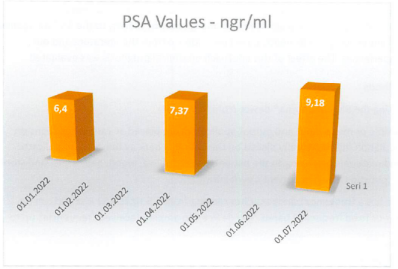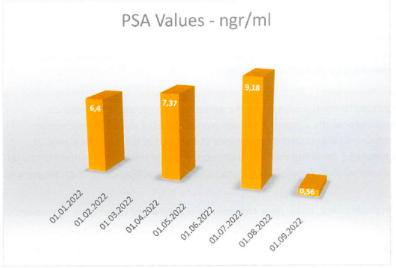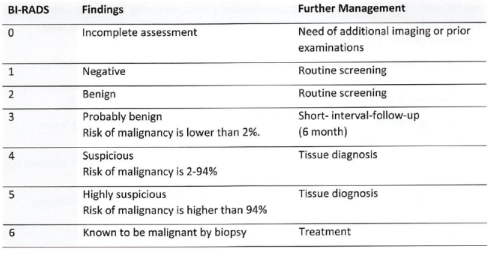
Could Bioresonance Be an Adjuvant Treatment Option in Oncology?
Esra Kirsever, MD, Private specialist in Obstetrics and Gynecology, Istanbul
Giilnihal Sisman, MD, PhD, Institute of Health Sciences, Department of Medical
Biochemistry, Bezmialem Vakif University, Istanbul
Today, the concept of energy medicine has regained attention after being considered a “forbidden area” in the academic scientific community and Western medical practice for years. Current studies draw attention to energy medicine approaches both for their remarkable effectiveness and the mechanisms that produce their effects.
Introduction
Cancer is one of the most common causes of death worldwide. After cardiovascular diseases, cancer is the second leading cause of death. In 2020, 19 million 292 thousand people worldwide were diagnosed with cancer, and 9 million 958 thousand people died from cancer. It is estimated that the number of deaths due to cancer will exceed 11 million by 2030 (1).
Therapeutic strategies for cancer are determined based on the type, location, and stage of the cancer. Current cancer treatments include chemotherapy, immunotherapy or antibody-based therapy, radiation therapy, and surgery. In oncology, choosing the correct treatment strategy in the early stages of the disease is crucial for increasing the likelihood of remission and survival (1).
In patients with locally advanced tumors, the approach that aims to shrink the tumor by applying drug therapy as an in vivo sensitivity test before curative regional treatment (most often surgery or sometimes radiotherapy) is called neoadjuvant (induction) chemotherapy (2).
Serious side effects due to chemotherapy, immunotherapy, radiotherapy, and surgery not only impair the patient’s quality of life, but also have a restrictive role in treatment.
In the early 20th century, we see the first therapeutic applications of Complementary and Alternative Medicine (CAM) in cancer treatment. These treatments include Acupuncture,
Ayurvedic Medicine, Homeopathy and Naturopathy, Therapeutic Touch (Reiki), Color Therapy, and Pulsed Electromagnetic Field (PEMF) therapies. Although CAM practices are not generally seen as part of mainstream medicine, numerous studies in oncology support the development of new treatments to be added to current protocols to enhance the effectiveness of existing treatments, reduce side effects, and improve patients’ quality of life (12). Today, we can access 871 articles published on PEMF, 4007 on Low Frequency Electromagnetic Field therapies, and 77 articles on Bioresonance in PubMed.
Biophysical perpective on the origin of carcinogenesis
Coherence is defined as the physical alignment of wave characteristics within wave packets. Constructive wave interference leads to the production of specific resonance patterns that promote coherent cellular wave fields, and dynamic cell systems operate in part on this principle (3).
Schrédinger recognized that the coherent interaction of waves was linked to entanglement as “a characteristic aspect of quantum mechanics” and proposed that “eigenstates”, also called “preferred states”, could survive interaction with the environment. Coherent resonances may exist in electrons, photons, phonons, and quasi-particles like solitons (3).
The preferred location for resonance transfer in living cells is the surrounding areas of ion water clathrates, nucleic acids, and ion-protein complexes. Water molecule arrangements are known to be coherently nanostructured, and the resulting coherent domains influence biomolecular processes including protein conformation and stability, substrate binding to enzymes, as well as electron and proton transfer.
Carcinogenesis signifies a frequency model resulting from a gradual loss of coherent electromagnetic frequencies in cellular organization. Therefore, exposure of cells to coherent electromagnetic frequencies at a sufficient level can prevent cancer formation and even facilitate the
cure of the disease (3).
Carcinogenic frequencies are positioned in inconsistent soliton frequency regions. In contrast, cancer can be inhibited and delayed in coherent soliton frequency regions (3). The study of Meijer, D. K., & Geesink, H. J. (2018), emphasizes the existence of the dominant vibrational spectrum of EM fields in the initiation of life and stabilization of life systems as the “algorithm of living cells.(3).
With this knowledge it will be possible to develop innovative technologies that can effectively improve the life-sustaining coherence of electromagnetic signals.
Studies on the use of vibration medicine in oncology
There are several studies including in vivo, in vitro and also clinical studies in the literature, on the effectiveness of energy medicine in oncology (9,10,11). In vitro studies (Wang, M. H, 2021, Barati M. 2020, Blackstock, A. W. ,2021) provide clues that the Extremely low frequency Electromagnetic Field (ELF-EMF) model may provide a potential anticancer treatment in the future (1,4,5). Cameron, I.L. et al. have shown in their in vivo studies that radiotherapy (RT) and Electromagnetic Field (EMF) therapy inhibit tumor growth, angiogenesis and metastasis. However, although RT therapy had harmful side effects, EMF therapy had no side effects (6).
In clinical phase studies of Viktor P. (2022), it has been shown that the use of oncological disease nosodes used in bioresonance with the correct potency selection leads to the emergence of a destructive resonance with the tumor and healing of the disease. The use of the TheraBionic device in the treatment of 59 patients with advanced-stage Hepatocellular Carcinoma (HCC) has been shown to have a positive contribution to survival (7).
Since 2016, Viktor P. et al. have published several studies on the use of the second direction of therapeutic resonance – “Resonance of Creation”. Resonance not only destroys diseases, but can also create lost biological structures. This feature facilitates to treat degenerative diseases (7).
In our study of 52 cancer cases published in 2022, the palliative effectiveness of the BICOM® Bioresonance Therapy methodology in cancer treatment was demonstrated (8).
Bioresonance in oncology
Method
In Bioresonance Therapy (BRT), instead of suppressing symptoms when the disease occurs, factors causing the disease are identified and eliminated through frequency modulations. The disrupted regulation mechanism and balance are supported by reminding the body.
As a result, considering every stage of the disease progression, the disease is removed from the body. The organism returns to its initial healthy state.
Our approach to oncology cases with the BRT method aims to restore the disrupted balance of the sympathetic and parasympathetic systems and to open up blocked intercellular matrices.
The effects of BRT in cancer treatment are primarily explained by two mechanisms. First, the reflection of endogenous BRT on the tumor is different from that in normal tissues. This can lead to a direct cytotoxic effect. Secondly, by strengthening the immune system, it can induce an anticancer effect.
Objective
In our study, we examined the responses of patients with suspicious findings on imaging or increased risk of malignancy, or those diagnosed with malignancy by biopsy, to the BRT we applied before starting current oncology treatments, based on evidence from the literature and our previous clinical experiences. The effect of this approach on clinical prognosis was evaluated.
Materias and methods
BRT was applied using the BICOM optima® device from REGUMED.
In this method, flexible or metal input and output applicators are placed at various locations on the body. The modulation mat is typically placed on the patient’s back as the output applicator.
Biological fluids and materials belonging to the patient, such as saliva, blood, hair, urine, and stool, are placed in the input cup to deliver patient’s own information.
The BICOM® device has a frequency bandpass filter ranging from 1.3 Hz to 152 kHz and can be used with narrower or fixed frequency bands. The device can amplify received frequencies up to 0.05-64 times.
Test — therapy algorithm
For testing purposes, pathogenic factors such as as information from allergens, toxic chemicals, viruses, bacteria, parasites, etc., were detected using frequency testing techniques and the BodyBalanceCheck bioenergetic frequency diagnosis method. Affected organ meridian systems related to the disease were identified.
In therapy, basic blockages, immune system support, strengthening of detox organs, meridian therapies, and anti-tumor frequencies were applied.
Cases
Case 1: M.K.
A 84 years old male patient who was operated on for prostate cancer in 2007, applied to my clinic on December 5, 2022.
The patient was stable for twelve years in post-op period. However Prostatic Acid Phosphatase (PSA) values of the patient started to increase in 2019. Subcutaneous GnRH – Leuprolide acetate administration was started monthly. Despite this, starting from January 2022, the PSA values have begun to rise again. Biopsy was recommended due to the progressive increase in PSA values and
the suspicion of malignancy in Positron emission tomography—computed tomography (PET CT). The patient has stopped using Leuprolide acetate for the last three months.
PSA values before bioresonance therapy:
07.01.2022: 6.4 ngr/ml
14.04.2022:7.37 ngr/ml
07.07.2022: 9.18 ngr/ml

In the PET CT dated 02.08.2022 (before bioresonance treatment), a mass of 31×24 mm in size was reported in the left lung. The maximum standardized uptake value (SUVmax): 9.2.
Bioresonance treatment was started on December 5, 2022 for the patient, for whom biopsy was recommended with the preliminary diagnosis of prostate Ca recurrence. 15 sessions of BRT were applied. After the therapy, PSA: 0.564 ngr/ml was measured on 29.09.2022.

In the PET CT imaging performed on 22.09.2022, the mass in the left lung was seen with dimensions of 31×23 mm and SUVmax: 1.3.
The oncologists indicated that a biopsy was not necessary and recommended clinical follow-up. The patient has been stable for 20 months. He is not receiving any treatment, including BRT.
BIRADS Classification for Imaging in Breast Cancers

Case 2:S.Y.
A 42 years old female patient applied to my clinic on December 2, 2020 with the complaint of suspected lesions detected during repeated breast examinations. She had a history of Gravida3
Parity2 Abortus1 and a molar pregnancy.
On June 29, 2020, Breast Ultrasonography (USG) revealed a hypoechoic nodular lesion with lobulated contours measuring 13×8 mm at the 10 o’clock position of the left breast. It exhibited fine linear echogenic septa-like components and weak posterior acoustic enhancement, without detectable vascularity, suggestive of a dense cystic lesion or fibroadenoma. Follow-up was recommended six months later (BIRADS category 3).
Five months later, on November 11.2020, Breast Magnetic Resonance Imaging (MRI) revealed that the lesion had progressed to BIRADS category 4. It manifested as a retractile appearance measuring 1 cm in diameter at the anterior glandular contour level of the left breast’s outer quadrant. It is accompanied by a retracted appearance at the level of the anterior glandular contour with a diameter of 1 cm in the medium-slight upper part of the outer quadrant of the left breast. Due to the increased risk of malignancy, histopathological verification through biopsy was recommended. BRT was initiated on December 2, 2020, prior to biopsy, and the patient underwent 15 sessions of BRT.
Following BRT, a subsequent imaging assessment by the breast surgeon indicated regression of the lesion to BIRADS category 3 before biopsy. On January 5, 2021, a Tru-cut biopsy was performed. The histopathological diagnosis revealed stromal fibrohyalinization, lobular atrophy, and no evidence of malignancy. The patient has remained clinically and radiologically stable for over three years of follow-up.
Case 3: H.C.
A 47 years old female patient went through mammographic check-up during routine gynecological examination. On March 7, 2023, Breast USG revealed a mass measuring 17×10 mm with thickened borders and mild distortion at the 7 o’clock position of the left breast, without detectable vascularity (BIRADS 4A). Biopsy was recommended.
The patient stated that she wanted to receive BRT prior to the pathological examination.
BRT was started on March 2023. 15 sessions of BRT were applied. In the mammography performed on 01.04.2023 after the treatment, the lesion was evaluated as BIRADS 0.
The radiologist noted no pathological mammographic findings corresponding to the lesion identified on USG. Further imaging modalities were suggested.
The result of Breast MRI performed on 01.04.2023 was BIRADS 2 and also the result of Breast USG on 05.04.2023 was BIRADS 2.
The oncologist breast surgeon recommended clinical follow-up instead of biopsy, stating no necessity for it. The patient has been stable for one year.
Case 4: E.K.
A 38 years old female patient with Gravita2 Parity2 applied to my clinic for gynecological examination. During routine gynecological examination, mammography, and breast USG were requested for the patient. On May 3, 2023, mammography and breast USG revealed a 4.5×3 cm nodularity accompanied by increased parenchymal density and clustered amorphous calci- fications in the retro areolar region of the left breast. Due to ductal dilatation and calcified foci observed on the current USG, an MRI and biopsy were recommended (BIRADS 4A).
On June 16, 2023, BRT was initiated. Fifteen sessions of BRT were administered before the biopsy.
On July 8, 2023, breast surgeon performed a USG and reported that the retro areolar mass had decreased to an extent where it was no longer visible (BIRADS 3). It was decided to administer five more sessions of BRT.
Afterwards, it was observed that the mass in the retro areolar region became smaller, but the micro calcified appearance continued. A tru-cut biopsy was performed on the left breast on July 24, 2023.
As a result of pathology, ductal ectasia, apocrine metaplasia, and stromal fibrosis were observed. No signs of malignancy were observed.
Case 5:S.B.
A 43 years old female patient, who had a history of childbirth through in vitro fertilization, underwent biopsy due to a palpable mass in the left breast. She was diagnosed with Invasive Lobular Carcinoma. The patient presented to our clinic on August 18, 2023, before undergoing PET CT.
The pathology report dated August 15, 2023, indicated a tru-cut biopsy from the mass at the 11 o’clock position of the left breast, revealing Invasive Lobular Carcinoma Luminal B with Nuclear Grade lil.
BRT was initiated on August 18, 2023, and the patient received 15 sessions of BRT before PET CT.
The oncologic breast surgeon, who had observed the effectiveness of bioresonance therapy in previous cases, expressed the need for a repeat biopsy. The second biopsy performed yielded a pathology report dated September 7, 2023, indicating Invasive Lobular Carcinoma Luminal B with Nuclear Grade Il
Upon the regression from Nuclear Grade IIl to Grade II, further immunohistochemistry and Ki index analysis were requested. It was observed that the Ki index, which indicates the proliferation rate of cancerous cells in actively dividing cells, decreased from %35 to %6.
Discussion
In oncology, choosing the right treatment strategy in the early stages of the disease is very important to increase the likelihood of remission and improve survival. Serious side effects due to chemotherapy, immunotherapy, radiotherapy and surgery not only impair the patient’s quality of life, but also have a restrictive role in treatment.
Compared to current treatments, non-invasive, low side-effect, and cost-effective methods such as energy medicine methods, including bioresonance, can be chosen as supportive methods before undergoing conventional treatments in cases of suspected or diagnosed malignancies.
Conclusion
This treatment approach appears to potentially eliminate the possibility of malignancy in cases of suspicion and may lead to regression in the histopathology of the disease.
In this way, the patient will avoid being diagnosed with malignancy, and the effectiveness of current treatments will increase and their side effects may decrease. Comprehensive prospective randomized studies are needed to support this view.
References
1. Blackstock, A. W., Benson, A. B., Kudo, M., Jimenez, H., Achari, P. F., McGrath, C,, … & Pasche, B. (2021). Safety and Efficacy of amplitude-modulated radiofrequency electromagnetic fields in advanced hepatocellular carcinoma. 4open, 4, 3.
2. Trimble, E. L., Ungerleider, R. S., Abrams, J. A., Kaplan, R. S., Feigal, E. G., Smith, M. A & Friedman, M. A. (1993). Neoadjuvant therapy in cancer treatment. Cancer, 72(511), 3515-3524.
3. Meijer, D. K., & Geesink, H. J. (2018). Favourable and Unfavourable EMF frequency patterns in Cancer: perspectives for improved therapy and prevention. Journal of Cancer Therapy, 9(03), 188.
4. Wang, M. H., Chen, K. W., Ni, D. X., Fang, H. J., Jang, L. S., & Chen, C. H. (2021). Effect of extremely low frequency electromagnetic field parameters on the proliferation of human breast cancer. Electromagnetic Biology and Medicine, 40(3), 384-392.
5. Barati, M., Fahimi, H., Farahmand, L., & Madjid Ansari, A. (2020). 1Hz 160mT electromagnetic field induces apoptosis in breast cancer cells through up regulation of P38 and P21. Multidisciplinary Cancer Investigation, 4(1), 23-29.
6. Cameron, |. L, Short, N. J., & Markov, M. S. (2007). Safe alternative cancer therapy using electromagnetic fields. The Environmentalist, 27, 453-456.
7. Viktor MD, P. (2022). Resonant Medicine. International Journal of Medical Science and Clinical Invention, 9(02), 5962-5973. https://doi.org/10.18535/ijmsci/v9i02.04
8. Kirsever, E., Kiziltan, H. S., & Yilmaz, R. (2022). Palliative effects of bioresonance therapy with or without radiotherapy or chemotherapy on cancer patients. International Journal of Radiation Research, 20(1), 43-48.
9. Islamov B, Balabanova RM, Funtikov VA, Gotovskii YV, Meizerov EE (2002) Effect of bioresonance therapy on antioxidant system in lymphocytes in patients with rheumatoid arthritis. Bull Exp Biol Med.;134(3): 248-50.
10. Korkmazov Mlu Kokmazov (2008) Bioresonance. Main principles of bioresonance and electromagnetic therapy. Vestn Otorinolaringol.; 2:59-61.
11. Fedorowski A, Steciwko A, Rabczynski J (2004) Low-frequency electromagnetic stimulation may lead to regression of Morris hepatoma in buffalo rats. J Altern Complement Med.;10(2):251-60
12. Vadala, M., Morales-Medina, J. C., Vallelunga, A., Palmieri, B., Laurino, C., & lannitti, T. (2016). Mechanisms and therapeutic effectiveness of pulsed electromagnetic field therapy in oncology. Cancer medicine, 5(11), 3128-3139.
